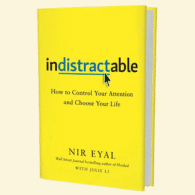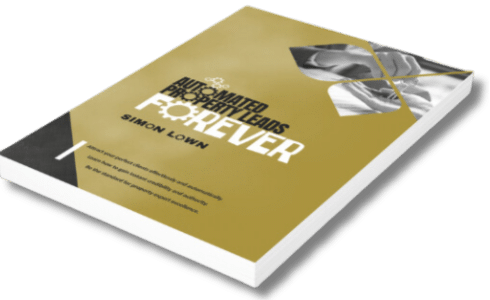If you want to grow your business organically and relatively stress-free, you’ll need to make time to start building your content goldmine.
By prioritising the creation of valuable content, you can attract and engage your target audience, establish your authority, and ultimately drive more sales. So, take a step back from your busy daily routine and make the time to develop your content strategy.
It will take some effort, but the results will be more than worth it.
Understanding the Power of Organic Content
Attracting your perfect prospect is what every business aspires to. Not having to spend a fortune on ads and still getting a steady stream of leads seems like a fantasy to most.
Sure, some big names make it look easy, but most are still spending more on ads than the majority of people earn in a year. Look, I don’t blame them; ads work. But, to get to the point of spending £1 and making £2 with ads is not something everyone can do.
The thing I’d like to make clear is that you don’t need to be a national treasure or local superstar to use the power of attraction marketing. All you need to do is show up where people are looking for answers and provide what they need.
Now, again, this is something many people struggle with, but it’s because they’re always looking for the next tip, trick, or tactic that will get them there overnight.
If you want to know the secret of getting an unlimited stream of prospects in your pipeline, it’s this.

That’s the “secret” to organic reach. Put in the work and show up everywhere your prospects go.
It sounds simple because it is. However, simple and easy don’t always go hand in hand.
Look at anyone who is successful, and you’ll find content. There will be a lot of content, whether it’s posts, blogs, books, videos, podcasts, or courses. For some, it’s all of the above. Others will specialise in one or two areas.
Without the content, their huge ad budgets would have nothing to promote. That’s the secret.
So, how do you do the same? Let’s look at that next.
Unveiling the Content Goldmine Approach
Creating a content goldmine is a lot of work and requires some planning. This is why making the time is essential.
Without the time to implement everything needed, your content goldmine will end up being another one of the “could have beens” of the world.
If you’re unfamiliar with what a content goldmine is and why you need one, I’ve already created some posts covering everything you need to know.
Please take a little time to read these posts first if you’ve not already done so. My definition of a content goldmine is slightly more in-depth than some you might have read elsewhere.
If you want to know more about creating your content goldmine, you can get my book, Automated Property Leads Forever, which covers everything you need to get started. You’ll find the link at the end of the post, so let’s move swiftly on.
In short, a content goldmine is the perfect way for a business to position itself as the home of go-to experts in their area. No matter what products or services you provide, building a content goldmine will establish a level of trust and rapport that no ad could ever achieve alone.
Content vs Expert Content
The main difference between what most people consider expert content and what I teach is the depth of the content.
If you think writing 500 to 1000 words or making a 5-minute video will satisfy somebody looking to solve a problem, I have some news for you. It won’t. Well, not unless it’s a really simple problem. But there’s little value in that, so let’s focus on solving BIG problems.
Besides, how will you tell stories and build rapport in a few hundred words? No, it would be best to learn how to create good long-form content that engages your audience and takes them on a journey.

And, if you’re wondering why it’s taken me around 700 words to get anywhere near the main focus of this post, maybe you’ll have a new appreciation for the attention to detail I am providing for you.
Context is a huge factor in establishing any credibility. If I were to start telling you about how to make the time for content creation without knowing that you understand what a content goldmine is and why you need one, you may very well finish reading this post and never get around to taking any action because the purpose of this post may be lost on you. (It’s to attract your perfect audience and get more clients on autopilot. Just in case you’d forgotten. 😉👍)
I certainly hope that is not the case, but this is why I spend time adding context to each of my posts so that you get the maximum value from whichever one you find first, with the expectation that you will use the knowledge to help you add value to your business.
So, let’s get started.
Time Management for Busy Property Experts
Not knowing who you are, how busy you are, or what time management techniques you use, it would be difficult for me to give any specific, meaningful advice here.

However, I can outline some of the more popular methods available and highlight why they work so well. This means you’ll need to evaluate the various techniques from an intellectual standpoint and compare them to how you currently manage your time. Then, once you have a favourite, commit to testing it for a month. That’s it.
Now, I do not doubt that problems will come up, interruptions will occur, and unavoidable issues will distract you from your planned content goldmine time.
It happens. Please don’t beat yourself up about it. Just deal with the problems and get back to it, or reschedule. Life happens, and sometimes it’s unavoidable. Deal with it and move on.
Just Do It
What I will say, though, is that putting it off, procrastinating, and finding things to keep you “busy” are normal reactions to something new and unfamiliar. This is particularly true if it’s something you feel you “must” do rather than what you “want” to do. If you feel like it will be hard and you’ll struggle to do it well, again, you’re probably not wrong. At first, anyway. We’ll cover why this is and what you can do about it very soon.
Anything new and unfamiliar will often seem complex and complicated. Think back to when you first started your property journey. How long did it take you to get to where you are today?
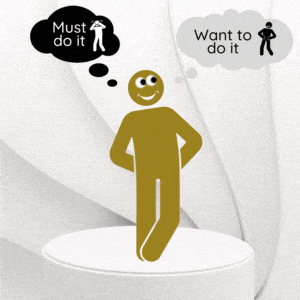
Content creation is a skill. It will take some time to become proficient. You will get there, though. There is no doubt in my mind. But only if you put in the effort. That means making the time and getting on with doing what needs to be done.
Time Management Techniques – Why You Need Them
Many business owners are so focused on getting things done that they lose sight of the big picture. If your business cannot run without you, it’s not a business; it’s a job. Stop focussing on the tiny details that don’t earn you any cash.

Your focus should be on the tasks that generate income or promote your services. If you have salespeople, sales closers, and sales progressors, your focus should be on marketing. Until your business generates organic leads on autopilot, you haven’t put enough effort into marketing your business effectively.
Without marketing, there are no leads. No leads mean no hot prospects. No hot prospects indicate you’re not getting nearly as many sales as you want.
If that’s not a circumstance you find yourself in, honestly, I’m uncertain why you’re here.
But, since creating a content goldmine is almost exclusively about positioning you as the go-to local property expert and attracting your perfect prospects, apart from making and progressing sales, creating new content will be one of your highest income-generating tasks.
Everything else should be delegated and outsourced. Well, mostly. We’ll cover more on that soon.
Now that you know why you need to free up your time, let’s see how to plan your time more effectively.
Time Management Methods
Here are a few methods you can use to plan your time. This list is not exhaustive, but they are known to be effective.
Set Clear Goals and Priorities
Determine your long-term and short-term goals. Goal setting allows you to stay focused if you’re uncertain about what tasks you should perform and which should be delegated. Prioritise the tasks that contribute towards achieving your goals.
Property professionals might set goals like closing a certain number of deals, increasing market share or improving client satisfaction. If these are your goals and your current work doesn’t help achieve them, delegate or outsource it.
Time Blocking
Schedule specific blocks of time for particular tasks and stick to them. This helps avoid procrastination and ensures focused work.
Use your calendar to reserve time for important tasks and ensure that your partners, team members, and staff understand that this time will not be disturbed unless the emergency is of the utmost importance.
If you do not train your colleagues and staff to respect this time, the chances are they won’t.
The Pomodoro Technique
Once you have your time allocated, try using Pomodoro’s to make the best use of it.
Work in focused 25-minute intervals with short breaks to maintain concentration and avoid burnout.
Find out more about Pomodoro’s here.

The Eisenhower Matrix
This method allows you to categorise tasks based on urgency and importance. You need to ensure you’re working on the right things.
Determine whether the task you’re working on is:
- Urgent/Important
- Not Urgent/Important
- Urgent/Not Important
- Not Urgent/Not Important
to determine what to tackle first and what to delegate or eliminate.
Being busy and being productive aren’t always mutually inclusive. Remember, if it’s not making you money or promoting your business, it’s often something you shouldn’t be doing yourself.
For more information on this method, visit https://www.eisenhower.me/.
One Task at a Time
The science is clear.
Multitasking is a myth.
While we may feel like we can juggle multiple tasks simultaneously, our brains are not wired for it.
It is possible to listen to music and clean your home or have a conversation while doing the dishes, but these are not complex tasks.
If you try listening to a podcast while writing your latest post, you’ll soon see what I mean.
Feel the Flow
Now, why is this important?

Simply, when you switch tasks, it can take anything from 5 to 20 minutes to get into a state of flow. Getting fully immersed in your content creation and even enjoying the process is far less likely if you only do it when you get 10 minutes free, or you’re in between meetings, for example.
Setting time aside dedicated to content creation will make you much more productive. Another benefit will likely be clear and concise content that needs far less editing than anything you create between other tasks “as and when”.
Let’s look at some of the evidence around multitasking.
What the Science says
Our brains are serial processors, not parallel processors. This means we can only focus on one thing at a time. When we try to multitask, we’re really just rapidly switching our attention back and forth between tasks.
This constant context-switching is cognitively taxing and leads to various negative outcomes. Let’s look at them.
Reduced accuracy and efficiency
Studies have shown that multitasking can lead to a significant decrease in performance on both tasks. For example, one study found that people who multitasked while driving were involved in more rear-end collisions than baseline or alcohol drivers, with an estimated odds ratio of 5.36, similar to the risk of drivers with a blood alcohol level of 0.08%.
There’s more, so I’ve included links to the studies if you’re unconvinced. But, I think you already know, if you are a driver, distractions are a serious issue.
Increased errors
The more complex the tasks, the more likely we will make mistakes when multitasking. Personally, I find that even listening to music can be enough to distract me while I am writing. It depends on what I am writing about, but it is more noticeable for subjects I need to think about more. If the subject isn’t second nature to me, I’ll focus on my writing, and the music will almost be pushed out of my consciousness. If I am totally familiar with a topic, I can sing along at the same time. Now if you’ll excuse me, Ellie Goulding is about to get to the chorus of ‘Worry About Me’ and I need to join in. 😆
Reduced creativity and problem-solving
Multitasking can also hinder our ability to think creatively and come up with solutions to problems. Creative thinking is not something you can have a go at, well, in my experience.
It’s more of an all-or-nothing endeavour. It makes sense to me that this would be the case. While the odd idea can sometimes seem as if it came from nowhere, it often as a result of struggling to work through a problem.

Increased stress and anxiety
The constant pressure to switch between tasks can lead to increased stress and anxiety.
I can imagine this is more the case in a high-pressure environment where people try to do things as they are asked about them rather than planning a strategy to complete everything in an orderly manner.
What does all this mean?
No matter which study you look at, it is pretty much conclusive that multitasking doesn’t work. Where studies might indicate a positive outcome, it is usually a tenuous link. The tasks were likely to be simple, or the results have not been replicated or confirmed as scientific fact.
Do yourself a favour and focus on one task at a time. Accept it’s a fact that it’s more efficient. You’ll get more done in less time.
Let’s carry on with some other time savers.
To-Do Lists

Organising and prioritising tasks using To-Do lists is of course possible. It may not be the best method, though. I include it here to highlight the downside of To-Do’s rather than as a go-to method. You’ll need to decide which side of the To-Do fence you come down on.
For balance, I’ll start with some of the benefits of using To-Do lists:
To-Do’s – The Upside
While to-do lists have their drawbacks, used strategically they can also provide some useful structure and productivity benefits.
Prioritisation and Focus
To-do lists allow you to capture all your tasks in one place and prioritise the most important ones. This visual overview helps maintain focus on the actions that will move the needle on your goals.
Sense of Achievement
Checking completed tasks off your list provides a sense of progress and achievement. This can boost motivation to keep powering through your workload.
Memory Aid
Handy reminders ensure you don’t forget about unfinished tasks. No more worrying about dropped balls when it’s all written down.
Stress Relief
Getting your tasks out of your head and onto paper can provide mental clarity and relief. The list becomes your external brain. If you feel that is something you benefit from, I wholly recommend Tiago Forte’s book, Building a Second Brain. It takes this method to a whole new level.
Time Management
To-do lists lend themselves well to time blocking, allowing you to allocate set times to tackle items based on priority and workload.
To-Do’s – The Downside
Here are some of the main reasons why a to-do list might not suit you. If you find yourself experiencing these issues, perhaps look for an alternatice method of managing your tasks.
Overwhelm and Anxiety
Lengthy lists can feel daunting and might lead to procrastination or avoidance. The sheer volume of tasks can trigger stress and anxiety, making it harder to focus on any single item.
The constant addition of new tasks can create a sense of never-ending work, leading to burnout and a feeling of inadequacy.
There’s got to be a better way. Right?

Incomplete Tasks and Guilt
Unfinished items can create a sense of guilt and failure, especially for people who tend to be perfectionistic or have difficulty prioritising. The Eisenhower method is much more effective for dealing with this.
Carrying over incomplete tasks to the next day can reinforce a feeling of overwhelm and lack of progress.
False Sense of Productivity
Crossing off tasks can become a distraction or a substitute for actual accomplishment. The satisfaction of completing small, manageable tasks can lead to neglecting more important but challenging ones.
Focusing on checking items off the list can overshadow the quality of work and the value of meaningful progress.
Rigidity and Lack of Flexibility
Strict adherence to a to-do list can hinder adaptability and spontaneity. Unexpected events or opportunities may be missed due to a rigid focus on the predetermined list.
The pressure to stick to the list can stifle creativity and the ability to flow with changing circumstances.
Overemphasis on Quantity Over Quality

To-do lists can prioritise checking off tasks rather than focusing on the quality of work and meaningful outcomes. This can lead to rushed work, missed opportunities for improvement, and a sense of emptiness despite a seemingly productive day.
Quality should always be the priority. If a job is worth doing, it’s worth doing well. Excellence is a virtue. Add your own cliche’s ad infinitum.
Neglect of Unlisted Tasks
Tasks not explicitly written down may be overlooked or forgotten, leading to missed deadlines or incomplete work.
Being dependent on the list can create a false sense of security, diminishing attention to essential tasks that aren’t captured on them.
It’s important to note that to-do lists can be practical for many people but aren’t universally beneficial. Understanding the potential drawbacks and using them strategically is crucial for maximising their effectiveness and avoiding potential pitfalls.
Eliminate Distractions
Minimise distractions like social media, phone notifications, and unnecessary meetings to maximise focus during work.
This is an art in and of itself, so you’ll not be surprised to hear that people are specialising in removing distractions, too.
I would recommend you look up Nir Eyal with Julie Li’s book called Indistractable. I listened on Audible, as I do with most books these days, and it’s a real eye opener. If you ever wondered why those little notifications are so additictve, it’s “Because They Were Designed That Way“. There’s also plenty of content on the website to get you started if you’re unfamiliar with them.
More Time Savers for Property Professionals
When it comes to protecting your time, there are other areas you can focus on. This will depend on your services, but here are a few more time savers to consider.
CRM Optimisation
Leverage your client relationship management (CRM) software to automate repetitive tasks, manage leads efficiently, and schedule appointments, freeing up time for client interaction and deal closings.
Integrating your CRM into your automation is key to building a content goldmine. A fully mature content goldmine can generate hundreds, if not thousands, of leads every month. If you had to follow each one up manually, you’d never have time to service your clients. If this is not something you’ve considered before now, we will cover this in more detail in other posts.
Email Management

Implement email filters, set aside dedicated times for checking and responding to emails, and avoid constant checking to prevent distraction and information overload. If you train your clients to know when you manage your emails, you can reduce your distractions by turning email notifications off. Effective Communication
Streamline communication with clients and colleagues through clear email templates, meeting agendas, and follow-up systems to stay on track and avoid misunderstandings. This is a big part of creating a content goldmine, so if you don’t already do this, following my system will ensure that you will.
Travel Optimisation
I know this isn’t always an option, but it’s worth trying to minimise travel times and your number of journeys.
Plan travel routes efficiently to minimise commuting time and maximise time spent meeting clients or attending viewings. Use technology like online scheduling tools and virtual meetings to reduce unnecessary travel.
Delegate and Outsource
Consider delegating administrative tasks like data entry or reporting to assistants or outsourcing them to free up time for core activities like content creation, negotiations and property viewings.
Another book recommendation is coming up. If you’re uncertain about what you should be outsourcing, there is a fantastic book by Rob Moore called Life Leverage. Rob goes through calculating the value of your time and how to maximise the efforts you can put into your income-generating tasks.
Work-Life Balance
This one is just a friendly reminder. Schedule downtime for personal life and leisure activities to prevent burnout and maintain your energy levels for a demanding business.
This is not something you can take lightly. It will also affect your health and personal life if you don’t make time for them. Take time to enjoy yourself. You know you’re worth it.
Focus on What Matters
As a final push in the right direction, I’d like to take a minute to remind you that just because something can be done quickly, it doesn’t necessarily mean it’s worth doing. The reverse is also true. If something takes a lot of time, as long as it aligns with your goals, it’s worth sacrificing other lower-value, maybe more easily achievable tasks.
Valuing your time doesn’t always mean getting lot’s of things done. It is just as valuable to get one really high-value and important task completed.
To ensure you’re doing this effectively, here are a few more tactics you can use.

Focus on results over time spent
Measure your productivity by output rather than hours worked. Let me see if I can come up with an example of this principle in action.
Would it be better to spend 1/2 a day:
- clearing down your list of low value tasks that anyone could easily achieve.
or
- creating a high value piece of content that could be found by 10,000 people or more in your area, on Google, over the next couple of years?
Take a minute. Have a think about it. No, really, don’t rush it.
On the one hand, you can feel like you’ve had a really productive day. On the other, you might generate 10’s if not 100’s of thousands in potential income over the next few years.
Yeah! Guess which one I’m doing.
Track your time
Use time-tracking tools to identify areas where you can improve your efficiency.

This can be tricky and depends on how many activities you perform daily/weekly. A basic app might not be suitable if you’re a business owner who runs and manages daily tasks and delivers services.
I’ll list some options here for you to check out, but remember that you must match your needs with the software’s capabilities.
These apps will track and manage your time well if you don’t have too many tasks. They are more attuned to tracking billable time on multiple projects than analysing an MD/CEO’s busy day.
For more professional time study apps, you might try these:
Whether you use an app or another method, understanding how you spend your time is the only way to start adjusting and improving your daily routine. There is a section about this in Rob’s book, Life Leverage, so I won’t get into this here since I do recommend you get a copy.
Review and adjust
Once you know how you spend your days, you can review your time management system and adjust it as needed to adapt to changing priorities and workloads. Focus on your goals, and set milestones you can celebrate along the way.
As you start to delegate the lower-value tasks and free up your time for content creation, you’ll want to use that time as efficiently as possible. So, let’s look at how you might do that next.
Efficient Content Creation Techniques
To be clear, being super-efficient is not something you’ll be able to achieve from day 1. Please know that it will get easier. Get started, and you can figure out the rest on the way.
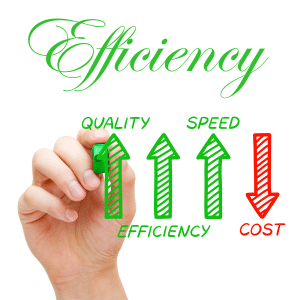
Remember, you are an expert. You have the knowledge. The reason you are doing this is because you want to help people. Once you’ve got the basics down, you’ll be able to capture lead information, nurture your audience from lead through to hot prospects, and increase sales effortlessly. Always remember your goals and the reason you’re doing this in the first place.
When you get started, and you’re learning about
- Creating Amazing Headlines
- Researching Your Competitors
- Choosing the Right Keywords
- Outlining Your Content
- Presenting Your Content Effectively
and various other content-related tasks, you might feel overwhelmed. There is no need to get flustered. Just take each task in turn. Figure out what works best for you, and then move on to the next, and the next, and the next, until you finally have a fantastic piece of content to publish.
When you have the basics under your belt, here are some ways to use your time more efficiently.
Batching and Scheduling
Grouping similar content creation tasks, like writing all your social media captions for the week at once, can help you get into a flow state and save time switching between contexts.
Planning your content calendar and scheduling publishing dates in advance can eliminate the need for last-minute scrambling and ensure consistent output.
Consistency is a huge part of content creation and can make or break your content goldmine.
Repurposing and Repackaging
Repurposing your existing content, such as blog posts, videos, and podcasts, into different formats like infographics, social media posts, or shorter video clips to maximise reach and engagement is an intelligent use of your time.
Create your content once and use it in dozens of locations to appear omnipresent without creating every piece from scratch.
This is a huge topic, and I will write more about how to do this in future. If you can’t wait, many resources are available to help. Google knows. 😊

Focus on creating content that remains relevant and valuable over time, like listicles, how-to guides, or industry reports, to reduce the need for constant content creation. These are also great for attracting perfect prospects and capturing their details for follow-up nurturing sequences.
Leveraging Tools and Templates
Utilise tools like Canva, Hootsuite, or Grammarly to streamline design, scheduling, and editing tasks, saving you time and effort.
The How to Boost Your Website Authority and Online Presence post has a great list of tools to get you started.
Create reusable templates for blog posts, email newsletters, or social media graphics to avoid starting from scratch each time.
Streamlining the Research and Writing Process
Curate and share valuable content from other sources to supplement your content creation and save time on research.
Using outlining tools or mind maps to organise your thoughts and structure your content before writing can improve efficiency and focus.
Dictation software can be faster than typing, especially for long-form content, and can help overcome writer’s block. If you’ve been following my posts, you’ll know I have other ways to help with writer’s block.
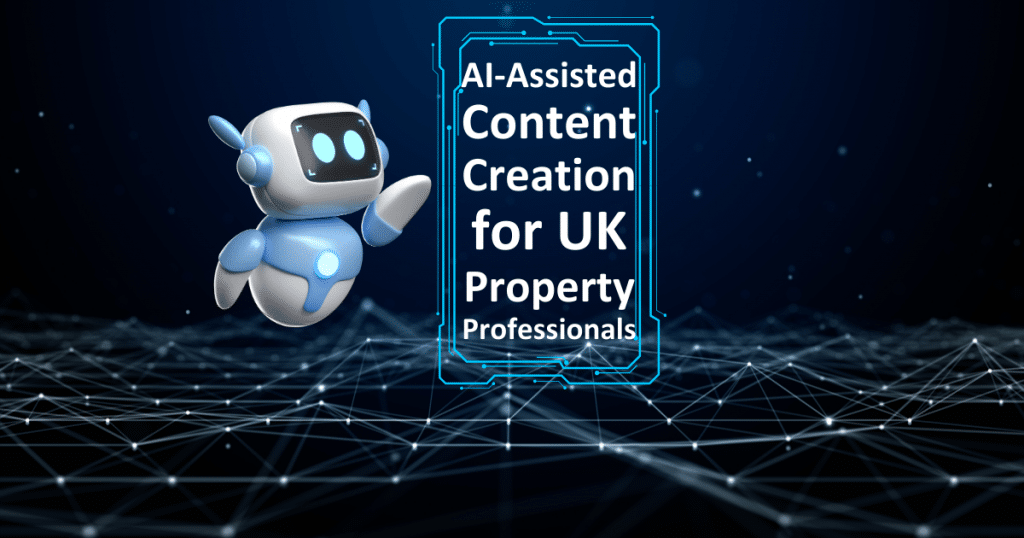
If you haven’t, check this post out: AI-Assisted Content Creation for UK Property Professionals.
Focusing on Quality Over Quantity
It’s better to publish fewer high-quality pieces than a lot of mediocre content. This will attract and retain your audience more effectively. Consistency is still important, but that doesn’t mean every day.
Ensure your content is optimised for search engines to reach a wider audience organically and reduce the need for paid advertising. I have a few posts covering SEO; have a quick look and check them out.
Collaborating and Delegating
Partner with other experts or influencers in your niche to create content, reducing workload and potentially boosting reach. I also discuss this in the How to Boost Your Website Authority and Online Presence post.
Delegate tasks like editing, graphic design, or social media management to freelancers or virtual assistants to free up your time for core content creation. Your message will do the heavy lifting, so getting help with all the other bits that don’t need you to do them shouldn’t be done by you.
Overcoming Creative Blocks
Even the most creative people will occasionally have a bad day, lose inspiration, or just get stuck on a particular topic.
Being constantly creative is a challenge for anyone, let alone a busy property expert still learning the ropes around content creation and social media mastery.
Fear not; help is at hand.
For the past year, there has been a crazy explosion of AI tools and apps that can assist with pretty much anything. This also includes helping you to create your content.

Now, I am not suggesting, for even a second, that you get AI to create your content for you. However, you can get AI to assist you.
Fortunately, as I’ve already mentioned, I have written another post about how you can do that. There is even an example of how to get the best results. I take you through everything you need to get started and how to have Chat GPT outline your post in full, which you can then check against your own research to ensure your post will be the best available once you’ve written it.
Check out the post here: AI-Assisted Content Creation for UK Property Professionals.
There is no one-size-fits-all when it comes to creating content. The most efficient content creation techniques will vary depending on your niche, audience, and workflow. How you work and your available time will also impact your creation process. Experiment with different approaches and find what works best for you. Let’s start looking at how to reduce your workload to get the time you need.
Delegating Responsibilities
It’s best to start by identifying all the tasks suitable for delegation. Of course, you should avoid delegating tasks that are highly sensitive, confidential, or require your judgment or expertise. Anything involving critical decision-making must stay with you or somebody else at your level.

Knowing who has various capabilities and what they enjoy doing is a great first step if you have a team. If you don’t have a team, taking on VAs or a PA will speed up your transition from working a job to running your business.
What you delegate and to whom will vary depending on your role and how involved you are in the day-to-day running of your business. Let’s look at how you can get started.
Delegation Framework
Use this framework to help you determine what can be delegated and outsourced and who is best suited to pick up the tasks.
- Evaluate all tasks for suitability and consider which ones are routine, time-consuming, outside your expertise, or don’t require direct involvement. You can use the Eisenhower matrix to assist with this. For example, not urgent/Important tasks may be an excellent place to start.
- Assess team members’ skills and interests and discuss their experience, career goals, and workload capacity.
- Provide opportunities for growth and development and delegate tasks that challenge and stretch their abilities but don’t overwhelm them.
- Consider the complexity and time sensitivity of each task. Start with smaller, less complex tasks while building trust and confidence before delegating more challenging projects.
- Set clear expectations and deadlines. Ensure everyone understands what needs to be done, when, and to what quality standards.
- Engage in open communication with your team. Ask for input and preferences and involve all team members in decision-making to foster ownership and buy-in.
- Explain the rationale behind delegation and help them understand how their contributions fit into the bigger picture. You might even get some help on the content creation front while you’re at it.
- Provide clear instructions and resources when outlining task expectations, deliverables, deadlines, and resources. Ensure clarity and understanding to avoid misunderstandings and rework.
- Offer guidance and support and be available to answer questions, provide feedback, and address challenges as needed.
- Monitor progress and provide feedback. Track progress, check in regularly, ensure tasks are on track, and give feedback to keep things moving forward.
- Offer constructive feedback and guidance to help team members learn and improve their skills.
- Recognise and celebrate successes. Appreciate your team’s efforts and contributions to boost morale and motivation. Include how well your content goldmine is performing so your team can see how their contributions are positively impacting the company.
Using this outline to identify the tasks you shouldn’t be doing yourself and delegating them to your team should free up enough of your time to enable you to focus on learning how to create expert content and build out your content goldmine.
Framework for Hiring Assistants
Now, should you not be fortunate enough to have a team, here is another framework you can use to hire outsourcers, VAs or a PA.
You’ll start the same way as the delegation framework by identifying what still needs your attention and what should be outsourced.
Once you’ve done that, you’ll then follow these steps.

Define Roles and Responsibilities
You need to group each of the tasks you want to outsource and start to define the properties that will allow you to find the right people.
Here are a few examples:
- Sourcer: Focus on generating leads and prospecting potential buyers/sellers.
- Virtual Assistant (VA): Handle administrative tasks, data entry, scheduling, and basic research.
- Personal Assistant (PA): Provide a higher level of support and manage your calendars, travel arrangements, communication, and project coordination.
Define Skillsets and Qualifications
Ensuring your new assistants have the requisite skills will be something you should spend time thinking about. The more detailed you can be in your outline, the greater the chance you’ll attract the right talent. Just remember that the higher the skills and the more proven a worker is, the higher the hourly rate will be.
- Sourcer: Strong communication, research, and lead generation skills, understanding of UK property market dynamics.
- VA: Excellent organisational skills, proficiency in software like MS Office, and attention to detail.
- PA: Proactive, strong communication and interpersonal skills, ability to anticipate needs and manage multiple tasks simultaneously.
Sourcing and Hiring
Once you know precisely what you want your new hire to achieve and the skillsets required, you’ll have to find somewhere to advertise your new position(s).
- Personal network: Reach out to your contacts in the industry for recommendations.
- Recruitment agencies: Specialised agencies cater to the property sector and can provide pre-vetted candidates.
- Freelance platforms: Upwork, Fiverr, and Freelancer.com offer access to a large talent pool.
- VA Agencies: Some agencies specialise in helping startups and can provide trained agents to help you. Check out The Property VA, Time Etc UK, and Bark. While it may cost a little more due to agency fees, you should find more pre-vetted assistants, which could save time.
Whichever route you take, the more information you can provide about the role you want filled and the skills you need to achieve the desired outcome, the better the chance you’ll get the right person.
Onboarding and Training
Once you take on an assistant, it is your responsibility to ensure they get up to speed with your company, systems, and methodologies as soon as possible. Even the most highly skilled workers cannot “hit the ground running” without insight into your goals, what you want them to achieve, and the tools they’ll have available to complete their tasks.
- Provide clear job descriptions and expectations.
- Training manuals and tutorials for specific software or systems.
- Regular meetings and feedback sessions to ensure alignment and address issues.
Communication and Management
Tools to monitor and manage their time may already be available depending on how and where you hire your VA/PA. If not, you’ll need to think about how you want to monitor progress.
- Utilise project management tools like Trello or Asana to assign tasks, track progress, and collaborate.
- Clearly communicate goals, deadlines, and reporting requirements.
- Schedule regular check-ins and feedback to maintain accountability and motivation.
The more precise you are about your expectations and requirements from the outset, the better the chances you get the work you need completing fulfilled to your required standard.

If you skip any of these steps, you’ll have to spend more time correcting problems, explaining what you need, and re-doing work you weren’t clear enough about.
Don’t be one of those “dick bosses” who expect people to know everything about their business when they haven’t even covered the bases themselves. You know who you are.
For everyone else, you can expect more free time and increased output from your well-informed, well-instructed team of VAs. Your competitors aren’t going to know what hit them when your Content Goldmine starts funnelling all of their “leads” into your pipeline of hot prospects.
I look forward to hearing all about it. 😉
A Few More Tips
Start slowly and build up rather than jumping in at the deep end. Trying to outsource everything at once is pretty much a recipe for disaster and will undoubtedly lead to a lot of wasted time.
- Start small and scale up as needed.
- Consider a trial period before committing to long-term contracts.
- Invest in tools and technology to streamline workflow and communication.
- Build relationships with your outsourced team members for better collaboration and loyalty.
By following this framework, UK property experts can effectively delegate tasks, reduce workload, and focus on core business activities that drive growth and success.
No More Excuses
Okay, we’ve determined that you need a content goldmine. You now know that you’ll need to make the time to work on it and that results won’t happen overnight. This is not something you will do for a weekend or two.
We’ve looked at how to validate everything you’re doing either generates income or promotes your services.
You have frameworks enabling you to delegate tasks or outsource them to skilled workers, freeing up your time to promote your business effectively. (That’s by building your content goldmine – in case you weren’t absolutely 100% certain).
You know you must onboard, train, and manage your VAs while setting expectations and standards.

You’ll set time aside for checking reports and updates and providing additional assistance, minimising the time you spend managing your people.
And you’re not going to be stuck wondering what to do next because you already know that you can ask AI to help with anything you’re uncertain about. (You did read that post at the end of the “Overcoming Creative Blocks” section, didn’t you…).
Let’s Go
Getting it all set up and running efficiently may take a little time, but you know what to do.
Creating a content goldmine is going to change your business and your life. Getting automated property leads on autopilot is a step-by-step process which you can follow. I’ve tried to make it as simple as possible by putting everything you need to know in these blogs and my book.
Investing your time in promoting your brand and services is one of the best decisions you will ever make for your business. Yes, it is a long-term proposition, but there really aren’t any downsides to creating expert content that automatically attracts your perfect prospects.
If you haven’t got my book yet, grab your copy now. It’s only £6.95, and everything you need to know is there. If you’re unsure about anything, comment below or join me on social media. I’m here to help.




